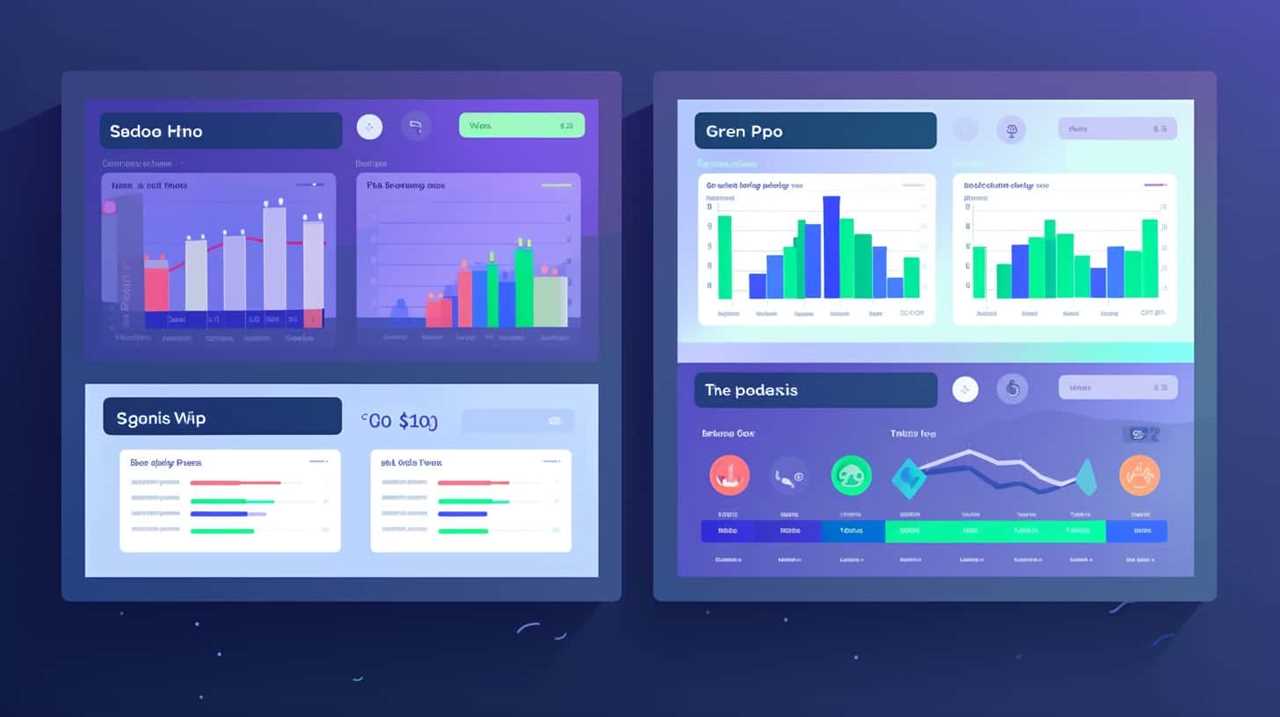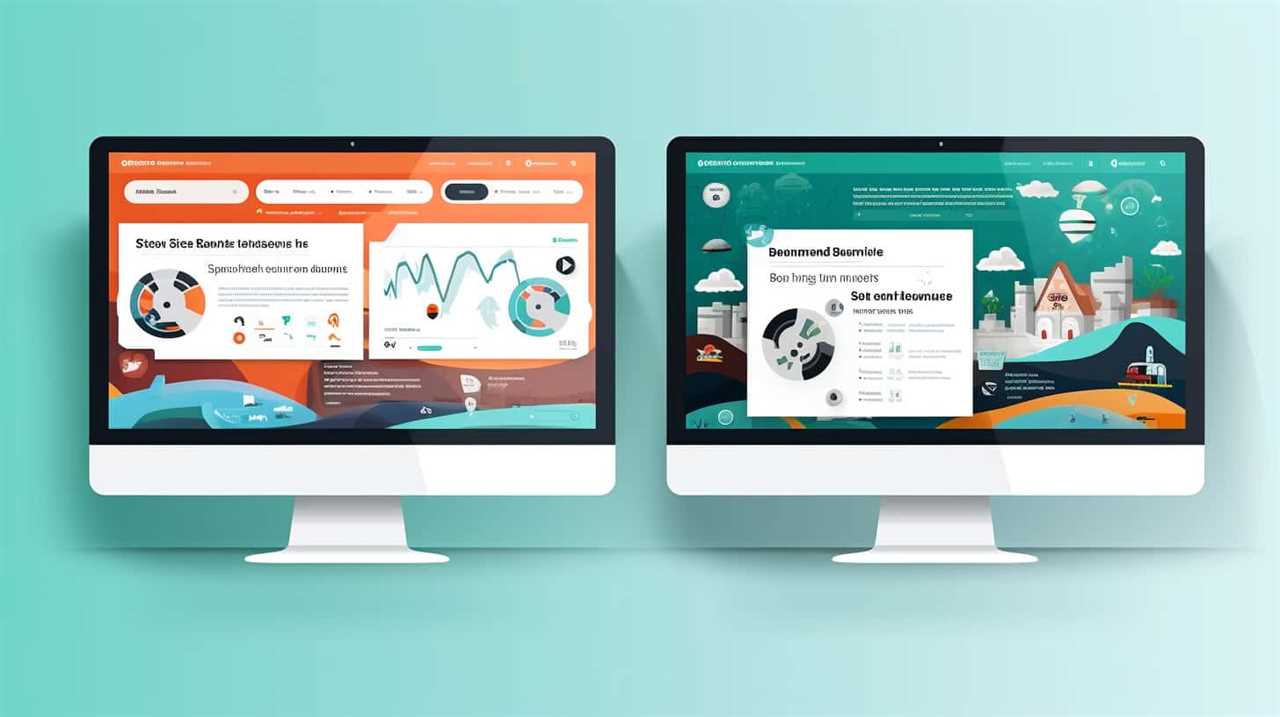Are you prepared to transform your healthcare practice? Google Ads is exactly what you need.
We’ve got the inside scoop on how to reach patients in your community and skyrocket your online presence.
With our targeted ads, you’ll be able to increase visibility in search results and attract local patients like never before.
But that’s not all – we’ll also guide you through tracking and analyzing your ad performance, A/B testing your campaigns, and utilizing ad extensions.

Get ready for Google Ads success in healthcare!
Key Takeaways
- A strong online presence is crucial for healthcare providers to reach patients in their community.
- Google Ads improve conversions by targeting users actively searching for relevant health information or services.
- Targeting local patients through Google Ads and utilizing local keywords and phrases is essential for effective targeting and connecting with local patients.
- Maximizing ad performance and results can be achieved through regular tracking and analysis, A/B testing, and optimization of landing pages and ad copy.
The Importance of Online Presence
In our experience, having a strong online presence is crucial for healthcare providers looking to reach patients in their community. With the rise of digital technology, online marketing has become a powerful tool in connecting with potential patients and establishing a reputable brand.
One key aspect of online presence is maintaining an active and engaging social media presence. Social media platforms such as Facebook, Instagram, and Twitter allow healthcare providers to connect with their community on a more personal level. By sharing valuable content, healthcare tips, and updates about services, providers can build trust and credibility among their target audience.
Furthermore, having a strong online presence through social media allows healthcare providers to reach a wider audience and attract new patients. With the ability to share posts, engage with followers, and run targeted ads, providers can effectively promote their services to individuals who may not have been aware of their practice otherwise. This can be particularly beneficial for healthcare providers who are looking to expand their patient base or introduce new services to the community.

Transitioning into the subsequent section about the benefits of Google Ads for healthcare providers, it’s important to note that a strong online presence lays the foundation for successful digital marketing strategies. By establishing a solid social media presence, healthcare providers can leverage platforms like Google Ads to further increase their online visibility and attract patients in their community.
Benefits of Google Ads for Healthcare Providers
We have found that Google Ads offer numerous benefits for healthcare providers looking to reach patients in their community.
One major benefit is the ability to improve conversions. With Google Ads, healthcare providers can create targeted ads that are shown to users who are actively searching for relevant health information or services. This means that the people who click on these ads are more likely to be interested in what the healthcare provider has to offer, increasing the chances of converting them into patients.
Another advantage of Google Ads is the ability to measure ROI (Return on Investment) accurately. Healthcare providers can track the performance of their ads and determine the effectiveness of their advertising campaigns. They can see how many clicks their ads receive, how many conversions result from those clicks, and even calculate the cost per conversion. This data allows them to make data-driven decisions and optimize their ads for better results.

In addition, Google Ads provide healthcare providers with the flexibility to set their own budget and control their advertising expenses. They can choose to spend more on ads during peak times or allocate their budget to specific geographic locations. This level of control allows healthcare providers to maximize their advertising efforts and ensure that their ads are reaching the right audience at the right time.
Targeting Local Patients Through Google Ads
When it comes to targeting local patients through Google Ads, there are a few key strategies to consider.
One important factor is utilizing geographical targeting options, which allow us to specifically tailor our ads to reach individuals in our community.
Additionally, incorporating local keywords and phrases into our ad copy can help ensure that our message resonates with the right audience.

Geographical Targeting Options
To effectively target local patients through Google Ads, healthcare providers can strategically utilize geographical targeting options to reach their desired audience. Here are three geographical targeting options and ad scheduling strategies that can help healthcare providers maximize the impact of their Google Ads:
- Location targeting: By specifying the geographical areas where healthcare providers want their ads to appear, they can ensure that their messages reach the right audience. This can be done by targeting specific cities, zip codes, or radius around a particular location.
- Demographic targeting: Healthcare providers can further refine their targeting by focusing on specific demographics such as age, gender, and household income. This allows them to tailor their ads to the specific needs and preferences of their target audience.
- Ad scheduling: By strategically scheduling their ads to appear at specific times of the day or week, healthcare providers can ensure that their ads are seen when their target audience is most likely to be searching for healthcare services.
By utilizing these geographical targeting options and ad scheduling strategies, healthcare providers can increase their visibility and reach local patients effectively.
Now, let’s move on to the next section about ‘local keywords and phrases’ to further enhance the effectiveness of Google Ads in reaching patients in the community.
Local Keywords and Phrases
Utilizing local keywords and phrases is essential for healthcare providers to effectively target and connect with patients in their community through Google Ads. When it comes to online advertising, local SEO plays a crucial role in optimizing ad targeting. By incorporating local keywords and phrases into your ads, you can increase the visibility of your healthcare practice among potential patients in your area.

To start, identify the specific keywords and phrases that are commonly used by local patients when searching for healthcare services. This may include terms such as ‘family doctor near me’ or ‘urgent care clinic in [your city]’. By including these keywords in your ad copy and targeting settings, you can ensure that your ads are shown to the right audience at the right time.
Furthermore, optimizing your ad targeting based on local keywords can also help improve the relevance and quality score of your ads. This, in turn, can lead to higher ad rankings, increased click-through rates, and ultimately, more patient conversions.
Increasing Visibility in Search Results
When it comes to increasing visibility in search results, there are two key strategies that healthcare providers can employ.
First, targeting local keywords is essential in order to reach patients in your community. By using location-specific keywords in your Google Ads, you can ensure that your ads appear in the search results of individuals searching for healthcare services in your area.

Second, utilizing ad extensions is another effective way to increase visibility. Ad extensions allow you to provide additional information, such as phone numbers, reviews, and links to specific pages on your website, which can make your ads more attractive and informative to potential patients.
Targeting Local Keywords
In our experience, we found that targeting local keywords significantly improves visibility in search results for healthcare providers. When you focus on local keywords, you have a better chance of reaching your target audience and standing out from the local competition.
Here are three reasons why targeting local keywords can make a big difference:
- Increased Relevance: By incorporating location-specific keywords in your Google Ads campaign, you can ensure that your ads are shown to users who are actively searching for healthcare providers in your area. This increases the relevance of your ads and improves your chances of attracting potential patients.
- Higher Conversion Rates: When you target local keywords, you’re more likely to attract users who are ready to take action and make an appointment. These highly targeted leads have a higher likelihood of converting into actual patients, resulting in a higher return on investment for your advertising efforts.
- Better Insights into Targeting Demographics: By analyzing the performance of your ads for different local keywords, you can gain valuable insights into the demographics and preferences of your target audience. This information can help you refine your marketing strategy and tailor your messaging to better resonate with your potential patients.
Utilizing Ad Extensions
To increase visibility in search results and enhance the effectiveness of our Google Ads campaign, we can leverage ad extensions. Ad extensions are additional pieces of information that can be added to our ads, providing more context and increasing the chances of attracting potential patients. There are various ad extension strategies we can employ to optimize our campaign.

One important ad extension strategy is to use location extensions. By including our healthcare facility’s address and phone number, we can make it easier for local patients to find and contact us.
Another useful ad extension is the call extension, which allows users to directly call our clinic with just one click. This can be particularly effective for mobile users who are looking for immediate medical assistance.
Furthermore, we can make use of sitelink extensions to provide additional landing pages for our ads. These sitelinks can direct users to specific pages on our website, such as services, testimonials, or appointment booking. By providing more options for potential patients to explore, we increase the chances of conversion.
Growing Your Practice With Google Ads
We can effectively grow our practice by leveraging the power of Google Ads. Here are three strategies that healthcare providers can implement to maximize their ROI with Google Ads:

- Targeted Keywords: Conduct thorough keyword research to identify the most relevant and high-value keywords for your healthcare practice. By incorporating these keywords into your ad campaigns, you can ensure that your ads are shown to the right audience at the right time. This will increase the chances of attracting patients who are actively seeking the services you offer.
- Ad Optimization: Continuously monitor and optimize your Google Ads campaigns to improve their performance. Test different ad variations, headlines, and calls-to-action to identify what resonates best with your target audience. Additionally, use ad extensions to provide additional information and enhance the visibility of your ads. This can include location extensions, call extensions, and sitelink extensions.
- Geo-targeting: Utilize geo-targeting to focus your ads on specific geographic locations where your target patients are located. By narrowing down your target area, you can optimize your budget and ensure that your ads are shown to the most relevant audience. This will help increase the chances of attracting patients who are within close proximity to your healthcare practice.
By implementing these Google Ads strategies for healthcare providers, you can effectively grow your practice and attract more patients.
Now, let’s dive into understanding Google Ads metrics for healthcare providers.
Understanding Google Ads Metrics for Healthcare Providers
To effectively measure the success of our Google Ads campaigns and make informed decisions, healthcare providers should understand key metrics and how they impact the performance of their ads. By analyzing these metrics, we can gain valuable insights into the effectiveness of our advertising efforts and make data-driven decisions to optimize our campaigns.
When it comes to Google Ads metrics analysis, there are several important metrics to consider. Let’s take a closer look at five key metrics that can help us measure the performance of our ads:

| Metric | Description |
|---|---|
| Impressions | The number of times our ads were displayed to potential patients. |
| Clicks | The number of times users clicked on our ads. |
| Click-Through Rate (CTR) | The percentage of users who clicked on our ads after seeing them. |
| Conversion Rate | The percentage of users who completed a desired action, such as making an appointment, after clicking on our ads. |
| Cost Per Click (CPC) | The average cost we pay for each click on our ads. |
By closely monitoring these metrics, we can gain insights into the effectiveness of our ads and make necessary adjustments to improve our campaigns. For example, a low click-through rate may indicate that our ad copy or targeting needs improvement, while a high conversion rate can suggest that our ads are resonating with potential patients and driving desired actions.
Measuring ad performance through Google Ads metrics analysis allows us to track the success of our campaigns, make informed decisions, and ultimately reach more patients in our community.
Setting a Budget for Google Ads Campaigns
When it comes to setting a budget for Google Ads campaigns, there are a few key points to keep in mind.
First, it’s important to focus on cost-effective ad strategies that can help maximize your return on investment. This means carefully selecting keywords and optimizing your ad copy to target the right audience.

Additionally, optimizing your ad spend is crucial in order to make the most out of your budget and ensure that your ads are reaching the right patients in your community.
Cost-Effective Ad Strategies
Our goal is to establish a cost-effective budget for our Google Ads campaigns targeting healthcare providers. To achieve this, we’ll implement several cost-saving strategies and conduct a thorough ROI analysis.
Here are three key approaches to consider:
- Targeted keywords: Conduct extensive research to identify relevant keywords that have a high search volume but low competition. By focusing on these keywords, we can optimize our ad spend and ensure that our ads are reaching the right audience.
- Ad scheduling: Analyze data to determine the peak times when our target audience is most likely to be searching for healthcare services. By scheduling our ads during these times, we can maximize our ad visibility and increase the chances of conversions.
- Ad optimization: Continuously monitor and optimize our ads to improve their performance and increase our ROI. This includes refining ad copy, testing different variations, and leveraging ad extensions to enhance ad visibility and engagement.
Optimizing Ad Spend
We carefully allocate a specific budget for our Google Ads campaigns, ensuring optimal utilization of resources while maximizing reach and engagement with our target audience.

When it comes to optimizing ad spend, it’s crucial to focus on maximizing ROI and implementing effective ad targeting strategies.
By monitoring the performance of our ads and analyzing the data, we can identify which keywords, demographics, and locations are generating the most clicks and conversions. This information allows us to make informed decisions about where to allocate our budget for the best results.
We also continuously refine our ad targeting strategies, ensuring that our ads are reaching the right people at the right time.
This targeted approach not only helps us maximize our ad spend but also improves the overall effectiveness of our Google Ads campaigns.

Creating Effective Ad Copy for Healthcare Providers
To create effective ad copy for healthcare providers, it’s essential to understand the target audience and tailor the messaging accordingly. By improving targeting and enhancing ad copy, healthcare providers can maximize the impact of their online advertising efforts. Here are three key strategies to consider:
- Speak directly to the needs and concerns of your target audience: Research your target audience thoroughly to identify their specific pain points and challenges. Craft your ad copy in a way that addresses these concerns and offers solutions. For example, if you’re targeting expectant mothers, focus on highlighting your prenatal care services and the personalized care you provide to ensure a healthy pregnancy.
- Use clear and compelling language: Keep your ad copy concise and straightforward while conveying the value and benefits of your healthcare services. Use strong and persuasive language to grab the attention of potential patients. For instance, instead of simply stating ‘We offer orthopedic services,’ try something like ‘Experience pain-free living with our advanced orthopedic treatments.’
- Incorporate social proof and testimonials: People trust the opinions and experiences of others. Include testimonials from satisfied patients in your ad copy to build trust and credibility with your audience. This can be in the form of quotes or star ratings. For example, ‘Rated 5 stars by our patients for our exceptional care and expertise in cardiology.’
Choosing the Right Keywords for Your Ads
When selecting keywords for our healthcare provider ads, it’s crucial to choose terms that accurately reflect the services we offer and align with the search queries of our target audience. Effective keyword research techniques can help us identify the most relevant and popular keywords for our ads. By conducting thorough keyword research, we can gain insights into the terms that potential patients are using when searching for healthcare services in our community.
To effectively target specific patient demographics, we need to consider the unique needs and preferences of each group. For example, if we want to reach young parents, we may want to focus on keywords related to pediatric healthcare, child vaccinations, or prenatal care. On the other hand, if we want to target older adults, keywords related to geriatric care, chronic disease management, or senior wellness programs may be more appropriate.
By strategically incorporating these keywords into our ad copy, we can increase the visibility of our ads and ensure they appear when our target audience is searching for relevant healthcare services. This won’t only drive more traffic to our website but also attract the right kind of patients who are more likely to convert into customers.

Optimizing Landing Pages for Better Conversions
To optimize landing pages for better conversions, it’s important to analyze the data from our keyword research and tailor the content and design of our landing pages to meet the specific needs and expectations of our target audience. Here are three key strategies to consider when optimizing landing pages:
- Improve user experience: A seamless and user-friendly experience is crucial for converting visitors into patients. Ensure that your landing pages are easy to navigate, load quickly, and are mobile-friendly. Optimize the layout and design to guide users towards the desired action, such as making an appointment or requesting more information.
- Optimize conversion rates: To increase the likelihood of conversions, focus on optimizing key elements on your landing pages. This includes crafting compelling headlines, writing persuasive copy, and using clear and enticing call-to-action buttons. Test different variations of these elements to identify what resonates best with your audience and drives the highest conversion rates.
- Continuously monitor and analyze data: Regularly review the performance of your landing pages using analytics tools. Look at metrics such as bounce rate, time on page, and conversion rates to identify areas for improvement. Use A/B testing to experiment with different elements and track the impact on conversions. By analyzing data and making data-driven adjustments, you can continually optimize your landing pages for better conversions.
Tracking and Analyzing Google Ads Performance
Now, let’s delve into tracking and analyzing the performance of our Google Ads campaigns to ensure their effectiveness in reaching patients in our community. Tracking performance and analyzing data are crucial steps in optimizing our campaigns and maximizing our return on investment.
Google Ads provides us with robust tracking and reporting tools that allow us to monitor key metrics such as click-through rates, conversion rates, and cost per click. By tracking these performance indicators, we can assess the effectiveness of our ads and make data-driven decisions to improve our campaigns.
Analyzing the data collected from our Google Ads campaigns allows us to gain valuable insights into the behavior and preferences of our target audience. We can identify trends, patterns, and areas for improvement. For example, by analyzing the data, we may discover that our ads perform better during certain times of the day or on specific devices. This knowledge can help us optimize our campaigns and allocate our budget more effectively.

In the next section, we’ll discuss tips for A/B testing our ad campaigns. A/B testing is a powerful technique that allows us to compare two versions of an ad to determine which one performs better. By implementing these tips, we can further enhance the performance of our Google Ads campaigns and ensure that we’re delivering the right message to the right audience at the right time.
Tips for A/B Testing Your Ad Campaigns
To enhance the performance of our Google Ads campaigns and ensure we’re delivering the right message to the right audience at the right time, we can implement A/B testing techniques. A/B testing allows us to compare two versions of an ad to determine which one performs better.
Here are three tips for conducting effective A/B tests:
- Define clear objectives: Before starting your A/B test, clearly define what you want to achieve. Whether it’s increasing click-through rates, improving conversion rates, or reducing cost per acquisition, having specific goals will help you measure the effectiveness of your ads accurately.
- Test one element at a time: To identify which specific element of your ad is impacting its performance, it’s important to test only one element at a time. This could be the headline, ad copy, call-to-action, or even the layout. By isolating variables, you can pinpoint what changes are driving better results.
- Monitor and measure results: Throughout the A/B testing process, closely monitor the performance of your ads. Use Google Ads’ reporting and analytics tools to measure metrics such as impressions, clicks, conversions, and cost per click. This data will provide valuable insights and help you make data-driven decisions to optimize your ad campaigns.
Ad Extensions for Healthcare Providers
When it comes to running Google Ads for healthcare providers, utilizing ad extensions can provide numerous benefits.

These extensions allow us to showcase additional information about our services, such as location, phone number, and links to specific pages on our website.
Benefits of Ad Extensions
In our experience as healthcare providers, we’ve found that utilizing ad extensions in Google Ads offers numerous benefits for reaching patients in our community. Here are three key advantages of using ad extensions:
- Maximizing ROI:
- Ad extensions allow us to provide additional information and value to potential patients, increasing the likelihood of them clicking on our ads.
- By including extensions like callouts, sitelinks, and structured snippets, we can highlight our services, expertise, and unique offerings.
- This ultimately leads to higher conversion rates and a better return on investment.
- Measuring ad effectiveness:
- Ad extensions provide valuable insights into the performance of our ads.
- By analyzing the data provided by extensions, such as click-through rates and conversion rates, we can gain a deeper understanding of which extensions are resonating with our audience and driving the most engagement.
- This information helps us make data-driven decisions to optimize our ads and improve their effectiveness.
- Enhancing visibility:
- Ad extensions increase the visibility of our ads on the search engine results page.
- With extensions, our ads take up more screen real estate, making them more eye-catching and prominent.
- This increased visibility not only improves our chances of attracting potential patients but also helps to establish our brand as a trusted healthcare provider in the local community.
Targeting Local Patients
By utilizing ad extensions, we can continue to target local patients effectively and efficiently. One of the key strategies in local marketing and community outreach is to make sure that our healthcare services are easily accessible to those in our community who need them. Ad extensions provide us with the opportunity to enhance our Google ads and provide additional information that is relevant to our local patients.
Here is an example of how ad extensions can benefit healthcare providers:

| Ad Extension | Benefit |
|---|---|
| Location Extension | Display our clinic’s address |
| Call Extension | Prompt patients to call us |
| Sitelink Extension | Direct patients to specific pages on our website |
Increasing Click-Through Rates
To increase click-through rates, we can further optimize our Google ads by leveraging ad extensions and providing additional value to potential patients in our community. By improving ad relevance and optimizing ad placement, we can capture the attention of our target audience and encourage them to click on our ads.
Here are three ways to increase click-through rates through ad extensions:
- Sitelink Extensions: These allow us to add additional links beneath our main ad, directing patients to specific pages on our website. By providing easy access to relevant information, we can increase the chances of users clicking on our ads.
- Call Extensions: Adding a clickable phone number to our ads enables potential patients to contact us directly. This convenience can lead to higher click-through rates, as patients are more likely to engage with our ads when they can easily reach us.
- Location Extensions: By including our clinic’s address and a map, we can help patients find our location easily. This added convenience improves the chances of users clicking on our ads, especially if they’re searching for a healthcare provider nearby.
Best Practices for Google Ads Success in Healthcare
With proper implementation and strategic targeting, healthcare providers can achieve Google Ads success within their community. In order to maximize the effectiveness of online advertising and digital marketing, it is important to follow best practices that have been proven to drive results. Here are some key strategies to consider:
| Best Practices | Description |
|---|---|
| Conduct thorough keyword research | By identifying the keywords that potential patients are searching for, you can optimize your ads to appear in relevant search results. This will increase the chances of attracting qualified leads. |
| Create compelling ad copy | Your ad copy should be concise, engaging, and highlight the unique value you offer. Use strong calls to action to encourage users to click on your ads and learn more about your services. |
| Utilize ad extensions | Ad extensions allow you to provide additional information in your ads, such as phone numbers, location, and links to specific sections of your website. This can enhance the visibility and credibility of your ads. |
Frequently Asked Questions
How Can Healthcare Providers Effectively Track and Analyze the Performance of Their Google Ads Campaigns?
We effectively track and analyze the performance of our Google Ads campaigns by utilizing advanced tracking tools and analytics. This allows us to measure the effectiveness of our ads and make data-driven decisions to optimize performance.

What Are Some Best Practices for Healthcare Providers to Achieve Success With Google Ads?
To achieve success with Google Ads, we optimize targeting strategies for better results. We create compelling ad copy that resonates with our target audience. It’s all about reaching patients in our community effectively.
Are There Any Specific Ad Extensions That Are Particularly Effective for Healthcare Providers?
There are several ad extension examples that can be particularly effective for healthcare providers. They can enhance the visibility and engagement of our ads, while also providing valuable information to potential patients. Additionally, measuring ad performance is crucial in optimizing our campaigns.
How Can Healthcare Providers Choose the Most Relevant Keywords for Their Ads?
When choosing the most relevant keywords for our ads, we focus on in-depth keyword research to ensure we’re effectively targeting patients in our community. It’s crucial to find the right words that resonate with our audience and drive results.
What Are Some Tips for Conducting A/B Testing for Healthcare Providers’ Google Ads Campaigns?
When it comes to A/B testing strategies for our Google Ads campaigns, we focus on optimizing ad copy to reach patients in our community. Here are some tips we’ve found helpful.

Conclusion
In conclusion, Google Ads can be a powerful tool for healthcare providers to reach patients in their community. By targeting local patients and increasing visibility in search results, healthcare providers can grow their practice and attract more patients.
Tracking and analyzing the performance of Google Ads campaigns is crucial for success, and A/B testing can help optimize ad campaigns. By utilizing ad extensions and following best practices, healthcare providers can maximize the effectiveness of their Google Ads and ultimately provide better care to their community.
So why wait? Start using Google Ads today and reach your patients where they are.










